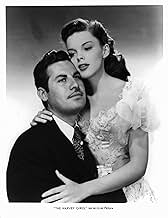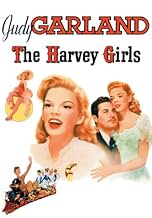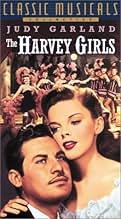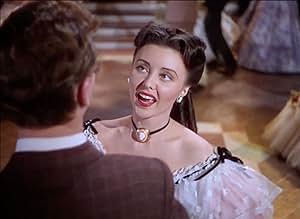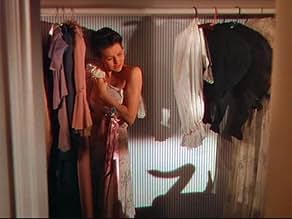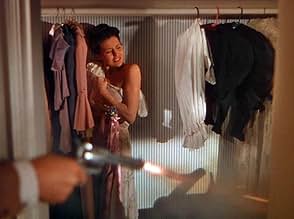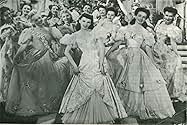IMDb-BEWERTUNG
7,0/10
5012
IHRE BEWERTUNG
Füge eine Handlung in deiner Sprache hinzuOn a train trip West to become a mail-order bride, Susan Bradley meets a cheery crew of young women travelling out to open a "Harvey House" restaurant at a remote whistle-stop.On a train trip West to become a mail-order bride, Susan Bradley meets a cheery crew of young women travelling out to open a "Harvey House" restaurant at a remote whistle-stop.On a train trip West to become a mail-order bride, Susan Bradley meets a cheery crew of young women travelling out to open a "Harvey House" restaurant at a remote whistle-stop.
- 1 Oscar gewonnen
- 1 Gewinn & 1 Nominierung insgesamt
William 'Bill' Phillips
- 1st Cowboy
- (as Wm. 'Bill' Phillips)
Handlung
WUSSTEST DU SCHON:
- WissenswertesIn the big production number "On the Atchison, Topeka and the Santa Fe," from Judy Garland's entrance until the conductor's "All aboard!" was done in one take. Legend has it that they shot it twice and Garland was dead-on move for move both times.
- PatzerIn the "Wild, Wild West" song, Alma is pounding a red-hot horseshoe. She then picks it up, caresses it, and throws it in the water barrel where it gives off steam. The horseshoe would have burned her hand if it were really hot. This is a sight gag in the film.
- VerbindungenFeatured in MGM Parade: Folge #1.25 (1955)
- SoundtracksIn the Valley (Where the Evenin' Sun Goes Down)
(uncredited)
Music by Harry Warren
Lyrics by Johnny Mercer
Performed by Judy Garland
Ausgewählte Rezension
"The Harvey Girls" is a splendid example of a well-crafted Metro-Goldwyn-Mayer musical from a time when well-crafted musicals were being dished out in abundance from Metro's golden bowl.
Inspired by the revolutionary success of "Oklahoma" on Broadway and tailored to fit the protean talents of it's young leading lady, Judy Garland, the film tells the story, in words and music, of a group of waitresses brought west in the late 1800's to open another link in the Fred Harvey chain of restaurants. In the process, they encounter all kinds of romantic and dramatic conflicts.
The cast is headed by Judy Garland, fresh from her triumph in the blockbuster musical "Meet Me In St. Louis" and her quietly moving dramatic performance in "The Clock". During the filming of "The Harvey Girls", Garland was one of the top box-office draws in the nation, and Hollywood's most versatile actress. She performs the role of Susan Bradley, an adventurous mail order bride who befriends the Harvey girls en route to New Mexico, with a vibrant comic touch. Her ability to combine tongue in cheek humor with her signature vulnerability is very satisfying in this film, and is an early highlight in her already legendary career.
The rest of the cast is first-rate: Angela Lansbury gives a wickedly fine performance as Em, the jaded dance-hall queen with hooded eyes and no-flies-on-me attitude. John Hodiak is the local tough guy and dance-hall owner, and also the object of Garland and Lansbury's affections. Broadway legend (and Garland's "Wizard of Oz" co-star) Ray Bolger does an amusing turn as the town's rubber legged blacksmith, and Preston Foster is the murderous Judge Purvis. The ranks of the Harvey girls are filled by some of Hollywood's most marvelous character actresses, including Marjorie Main and Virginia O'Brien, and the dancer Cyd Charisse in one of her first roles.
The film boasts what New York Times film critic Bosley Crowther appreciatively called "an abundance of chromatic spectacle and an uncommonly good score", the centerpiece of which is the Academy Award-winning song of the year (1946), "On The Atchison, Topeka, and the Santa Fe". This production number fills the screen with the colorful bustle of singers, dancers, and horses, and in the best Broadway tradition, advances the plot by introducing almost every cast member and giving them the opportunity to tell their story, in song, and their motivation for coming west in the first place. A spectacular bit of Golden Age musical magic, topped off by Garland's star turn entrance and full-throated belting of the Johnny Mercer/Harry Warren song.
The creative team behind this fable is as impressive as the talent in front of the camera. In addition to the score by Mercer and Warren, the film was directed by George Sidney ("Show Boat", "Annie Get Your Gun"), produced by Arthur Freed ("Singin In The Rain", "Gigi"), art directed by Cedric Gibbons ("The Great Zeigfeld", "The Wizard of Oz"), with musical direction by Lennie Hayton, orchestrations by Conrad Salinger, and musical arrangements by "Eloise" children's book author and singer Kay Thompson (a decade before she sizzled onscreen as the fashion magazine editor in the Audrey Hepburn classic "Funny Face").
This film will include restored Technicolor and stereo sound on DVD, and also a few musical numbers which were cut when the film was released due to length, and have been locked away in the MGM vaults. Now they have been restored, and the viewer can enjoy more of what film critic Howard Barnes called "a great big animated picture postcard."
Inspired by the revolutionary success of "Oklahoma" on Broadway and tailored to fit the protean talents of it's young leading lady, Judy Garland, the film tells the story, in words and music, of a group of waitresses brought west in the late 1800's to open another link in the Fred Harvey chain of restaurants. In the process, they encounter all kinds of romantic and dramatic conflicts.
The cast is headed by Judy Garland, fresh from her triumph in the blockbuster musical "Meet Me In St. Louis" and her quietly moving dramatic performance in "The Clock". During the filming of "The Harvey Girls", Garland was one of the top box-office draws in the nation, and Hollywood's most versatile actress. She performs the role of Susan Bradley, an adventurous mail order bride who befriends the Harvey girls en route to New Mexico, with a vibrant comic touch. Her ability to combine tongue in cheek humor with her signature vulnerability is very satisfying in this film, and is an early highlight in her already legendary career.
The rest of the cast is first-rate: Angela Lansbury gives a wickedly fine performance as Em, the jaded dance-hall queen with hooded eyes and no-flies-on-me attitude. John Hodiak is the local tough guy and dance-hall owner, and also the object of Garland and Lansbury's affections. Broadway legend (and Garland's "Wizard of Oz" co-star) Ray Bolger does an amusing turn as the town's rubber legged blacksmith, and Preston Foster is the murderous Judge Purvis. The ranks of the Harvey girls are filled by some of Hollywood's most marvelous character actresses, including Marjorie Main and Virginia O'Brien, and the dancer Cyd Charisse in one of her first roles.
The film boasts what New York Times film critic Bosley Crowther appreciatively called "an abundance of chromatic spectacle and an uncommonly good score", the centerpiece of which is the Academy Award-winning song of the year (1946), "On The Atchison, Topeka, and the Santa Fe". This production number fills the screen with the colorful bustle of singers, dancers, and horses, and in the best Broadway tradition, advances the plot by introducing almost every cast member and giving them the opportunity to tell their story, in song, and their motivation for coming west in the first place. A spectacular bit of Golden Age musical magic, topped off by Garland's star turn entrance and full-throated belting of the Johnny Mercer/Harry Warren song.
The creative team behind this fable is as impressive as the talent in front of the camera. In addition to the score by Mercer and Warren, the film was directed by George Sidney ("Show Boat", "Annie Get Your Gun"), produced by Arthur Freed ("Singin In The Rain", "Gigi"), art directed by Cedric Gibbons ("The Great Zeigfeld", "The Wizard of Oz"), with musical direction by Lennie Hayton, orchestrations by Conrad Salinger, and musical arrangements by "Eloise" children's book author and singer Kay Thompson (a decade before she sizzled onscreen as the fashion magazine editor in the Audrey Hepburn classic "Funny Face").
This film will include restored Technicolor and stereo sound on DVD, and also a few musical numbers which were cut when the film was released due to length, and have been locked away in the MGM vaults. Now they have been restored, and the viewer can enjoy more of what film critic Howard Barnes called "a great big animated picture postcard."
- classicfilmarchives
- 16. Apr. 2002
- Permalink
Top-Auswahl
Melde dich zum Bewerten an und greife auf die Watchlist für personalisierte Empfehlungen zu.
Details
Box Office
- Budget
- 2.524.315 $ (geschätzt)
- Weltweiter Bruttoertrag
- 1.417 $
- Laufzeit1 Stunde 42 Minuten
- Farbe
- Seitenverhältnis
- 1.37 : 1
Zu dieser Seite beitragen
Bearbeitung vorschlagen oder fehlenden Inhalt hinzufügen

Oberste Lücke
By what name was The Harvey Girls (1946) officially released in India in English?
Antwort

